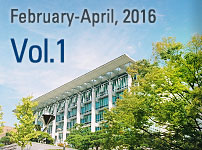SUNGKYUNKWAN UNIVERSITY (SKKU), SEOUL, KOREA
- Prof. Kilho Eom Research Team Has Reported How to Precisely Control
the Structure of Amyloid Fibrils - Tech Developed that Reduces Electric Current Loss between Metal & Graphene
- The Secret of a Conch Shell's Hardest Material:
Domestic Joint Research Team Observes a Nanoscale Process of Change - SKKU Researchers Develop 'Knitting Technique' to a Design Nucleic Acid Structure

The National Research Foundation of Korea (NRF) announced that a research team led by Prof. Kilho Eom has reported how to precisely control the structure of amyloid fibrils, which play a vital role in disease pathologies.
Amyloid fibrils, which play a crucial role on pathogenesis of neurodegenerative diseases such as Alzheimer's disease and Parkinson's disease, are known to be formed by aggregation of some intact proteins or fragmented protein chains. Though the pathological role of these fibrils has recently been found to be highly correlated with the molecular structures (or conformational diversity) of amyloid fibrils, the way in which the amyloid fibrils with their conformational diversity are formed has remained elusive.
The research work by Prof. Eom and his colleagues reports that microwave irradiation-based synthesis allows the precise control of the conformations (or structures) of amyloid fibrils, particularly their fibril lengths and helical structures. The research team unveiled that the conformational diversity of amyloid fibrils is attributed to the electrostatic interactions between amyloid proteins when they are aggregated to form the amyloid fibril.
This work provides insight into the fundamental mechanisms of amyloid formation, which are of great importance to understand how amyloidogenic diseases originate. In addition, as the research work provides how to control the molecular structures of amyloid fibrils, it also suggests de novo design principles applicable for devising the biomimetic materials such as protein fibrils with their controllable structures.
The research work by Prof. Eom and his coworkers was published at 'Scientific Reports' online edition on November 23, 2015.
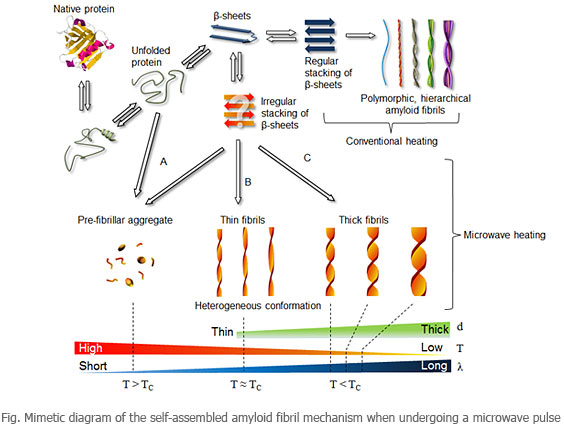
Find more information at:
http://www.nature.com/articles/srep16220

Korean researchers recently developed technology that can reduce electric current loss between metal and 'graphene' which is a revolutionary advanced material with many practical applications in electronics.
On February 16th, Prof. Park, Jin Hong at Sungkyunkwan University's School of Electrical and Electronic Engineering and his research team announced the new development which was made by changing the design of graphene. Compared to existing technology, the new design can reduce contact resistance between metal and graphene by about 25%.
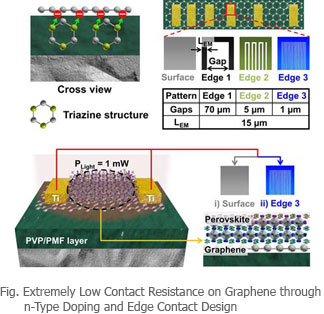 Electric current generally flows well through metal but does not in graphene. As a result, the intensity of the current flowing through is weakened when the two materials contact each other due to the rise in resistance. This leads to the poor performance of electronic devices that utilize graphene.
Electric current generally flows well through metal but does not in graphene. As a result, the intensity of the current flowing through is weakened when the two materials contact each other due to the rise in resistance. This leads to the poor performance of electronic devices that utilize graphene.
The research team succeeded in increasing the electronic density with the metal in contact by designing graphene with a longer edge. The higher the density of electrons, the better the current flows. In addition, they created an environment in which current can flow well by heating the materials that supply electrons under the graphene.
Prof. Park said, "Compared to existing graphene devices, we can secure an operating current that is about four times better. Since it maximizes the performance of next-generation electronic devices and optoelectronic devices, this new development is expected to have various applications, particularly in flexible instruments.
The results of this research were published in the international journal 'Advanced Materials' third monthly edition on February 3, 2016.
Find more information at:
http://onlinelibrary.wiley.com/doi/10.1002/adma.201503715/full

A domestic joint research team revealed why conch shells rarely become brittle or tear. On February 18th, a research team led by Prof. Oh, Sang Ho in the Dept. of Energy Science at Sungkyunkwan University (SKKU), and researchers from the Institute for Basic Science (IBS) in Pohang University of Science and Technology reported that conches have strong outer shell thanks to their structure in which nanosized crystals are arranged vertically.
A conch's outer shell is considered to be one of the hardest materials in nature. So far, even though scientists have strived to find out the secret of its hardness in order to utilize the quality in other materials, it remained a mystery.
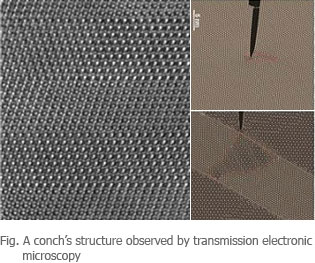 Researchers discovered that when a crack is applied to the shell (right top), the interfacial plane's crystal arrangement changes, blocking the crack (right bottom).
Researchers discovered that when a crack is applied to the shell (right top), the interfacial plane's crystal arrangement changes, blocking the crack (right bottom).
The research team focused on the special crystalline structure of conches. On a conch's shell, calcium carbonate crystal, which is uniformly arranged at a nanoscale interval, is piled up into a layer. Interface between layers consists of a 'twin crystal' structure with an arrangement direction that seems to have a form like mirrors facing each other.
The research team observed how a conch shell changes when it is cracked using a transmission electronic microscope which enables scientists to observe the change in nanoscale. It was revealed that when a crack occurs, interface of twin crystal plays a role in blocking the spread and change in direction of the crack. Since the external force is all used up to block the crack from spreading, a conch shell is rarely destroyed.
The energy required to destroy a conch shell is ten times higher than the energy needed for the destruction of 'aragonite', a mineral composed of calcium carbonate. Prof. Oh said, "If we imitate the structure of a conch shell, we will be able to develop new light and strong materials which would be apt for aviation or military uses." He also added, "It is meaningful that we were able to make these discoveries by observing what happened in nanoscale with an electronic microscope."
The research results were published online in 'Nature Communications' on February 17, 2016.
Find more information at:
http://www.nature.com/ncomms/2016/160217/ncomms10772/full/ncomms10772.html

A research team led by Prof. Um Soong-ho in Sungkyunkwan University's School of Chemical Engineering announced on Dec 4th that they have developed a 'Knitting Technique' to design a nucleic acid nanostructure.
The research team explained that a nucleic acid and an enzyme are each used as a thread and needle in a knitting process to synthesize and precisely control the creation of a nucleic acid structure that is several nanometers in size. Using this method it is much easier to create the desired structure than current techniques.
The research team says, "The nucleic acid structure created this way will not only be utilized in basic science, but also as a research material for new applied sciences as well."
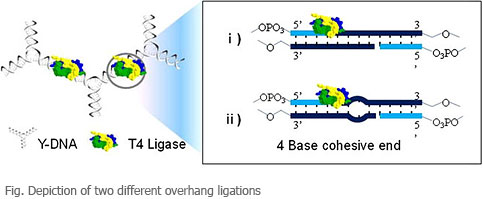
The research was published in 'Scientific Reports' online edition on December 4, 2015.
Find more information at:
http://www.nature.com/articles/srep17722
